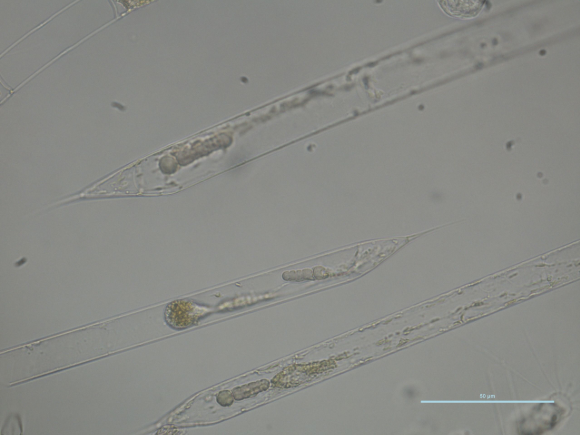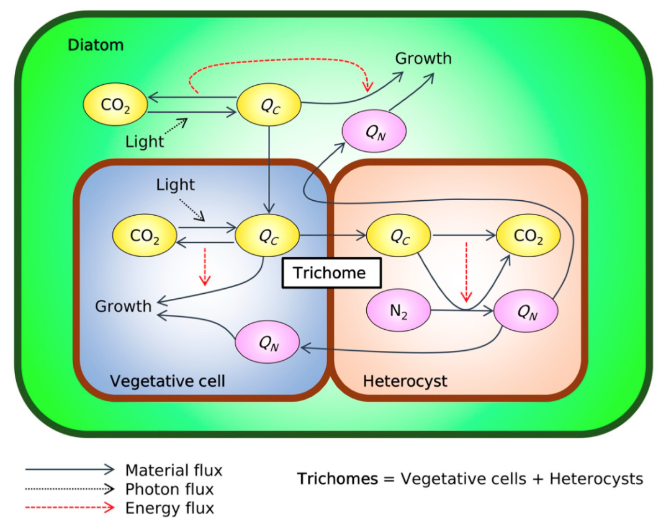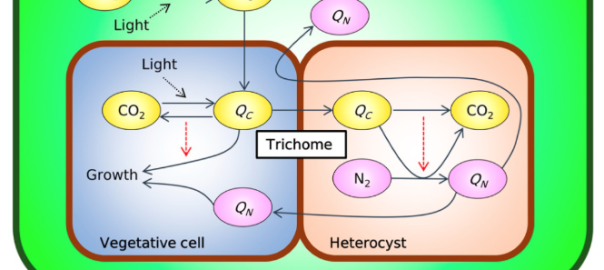Observations suggest diazotrophs like Crocosphaera and Trichodesmium pay for their ability to fix nitrogen with a very low growth rate, yet diatom-diazotroph associations or DDAs exhibit high growth rates. CBIOMES postdoctoral fellow Chris Follett and co-authors use a cell flux model to test the hypothesis that diatom-diazotroph associations or DDAs grow faster than unpaired diazotrophs because the diatoms in DDAs provide organic carbon to their diazotroph guests that boost their growth rate.
reporting by Helen Hill for CBIOMES
Gardeners will be familiar with symbiotic relationships in the vegetable patch, for example pairing beans and corn where bean plants contribute organic nitrogen (a fertilizer) to the soil that a companion planting of corn can benefit from. In the ocean, diazotrophs, (phytoplankton that derive their energy by fixing nitrogen) take nitrogen from the atmosphere and make organic nitrogen allowing them to outcompete other phytoplankton when organic nitrogen is limiting. Diatom–diazotroph associations (DDAs), symbioses where diazotrophs support the host diatoms with dinitrogen (N2) fixation, are a widespread marine planktonic symbiosis between several diatom genera and N2 fixing bacteria that allow diatoms to grow in nitrogen-poor conditions..
To explore how diazotrophs might support their host diatoms with dinitrogen fixation, Christopher Follett together with co-authors Keisuke Inomura, Takako Masuda, Meri Eichner, Ondřej Prášil and Curtis Deutsch, set out to quantify the reciprocal metabolic advantages of this symbiotic relationship through the development and analysis of a mechanistic model of a DDA. Their study was chosen as the cover story for the February 2020 issue of the journal Plants.

Micrograph from a 2015 SCOPE Cruise Hoe-Legacy 2. The three DDAs pictured are Rhizosolenia Richelia. The larger “pipette shaped” outer organisms are the diatom (Rhizosolenia) and the shorter chain of circular cells on the inside of each is the diazotroph (Richelia). Nitrogen fixation occurs in the largest cell (termed the heterocyst) at one end of the diazotroph chain (termed a trichome). The heterocyst is where the nitrogen fixation reactions actually occur. Both the larger cell size and a thickened wall help protect the inside from oxygen which would otherwise poison the nitrogen fixation reaction. The scale bar is 50 um. Micrograph courtesy C. Follett.
To model the chemical and energy transfer within a DDA the team capitalized on a cell flux model (a highly idealized model of metabolic pathways in an individual cell) that Inomura had previously developed and explored in the context of nitrogen fixation as part of his doctoral research. In such models, instead of explicitly handling thousands of individual chemicals, chemical types inside the cell are grouped into a more tractable smaller set of chemical classes (such as eg protein, carbohydrates, RNA, DNA, and lipids) and simple rules built to code the transfer of material between each class.

Schematic of the cell flux model of diatom–diazotroph association – from Inomura et al.
The team’s results suggest that carbon transfer from the host to the symbiont can account for the enhanced growth rate of DDA’s when compared with non-symbiotic forms while also demonstrating it is possible to build a simplified, intermediate scale, model based on cell size and composition of symbiotic nitrogen fixers.
“Our simulations showed that 25% of fixed carbon from the diatom is transferred to the diazotrophs, which is used for their growth and N2 fixation,” says Inomura. “In turn, 82% of nitrogen fixed by the diazotrophs was found to end up in the host diatoms. The model predicts that the carbon transfer from the diatom can increase the growth rate of the diazotrophs by 62%, explaining the observed high rates of growth and N2 fixation of the diazotrophs in DDAs relative to those of other non-symbiotic diazotrophs.”
To find out more about this work contact Chris
Publication
Keisuke Inomura, Christopher L. Follett, Takako Masuda, Meri Eichner, Ondřej Prášil and Curtis Deutsch (2020), Carbon Transfer from the Host Diatom Enables Fast Growth and High Rate of N2 Fixation by Symbiotic Heterocystous Cyanobacteria, Plants, doi: 10.3390/plants9020192
Other publications referenced
Inomura et al (2016), Development of a cell flux model and its application to nitrogen fixers, MIT Dept. of Earth, Atmospheric and Planetary Sciences, doctoral dissertation.
